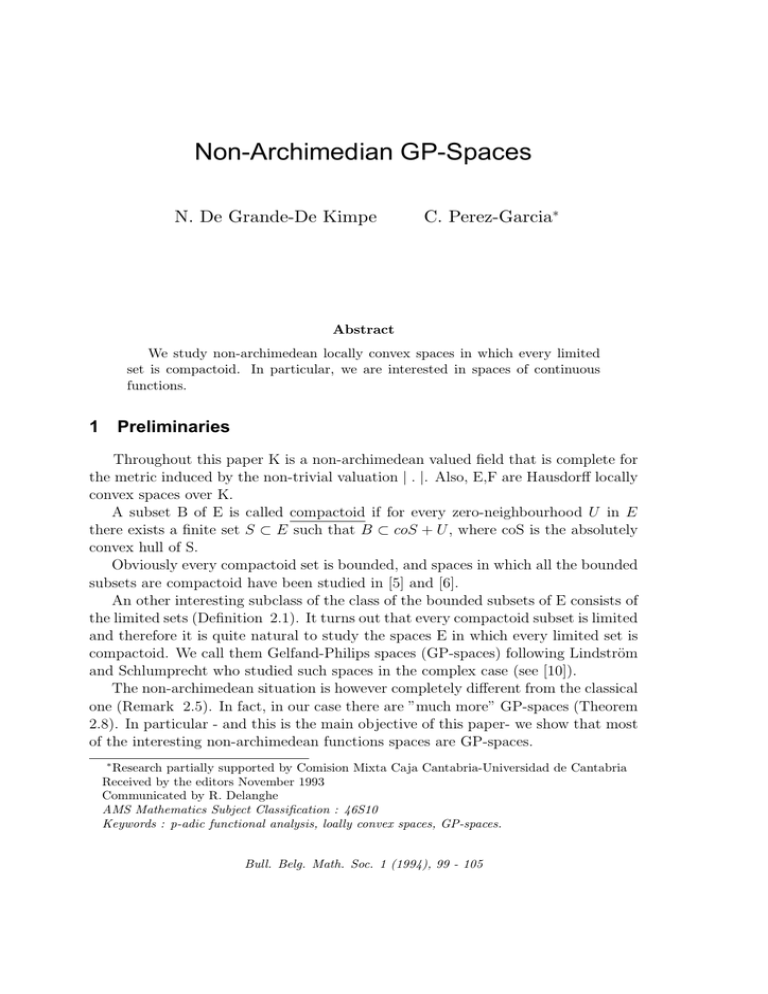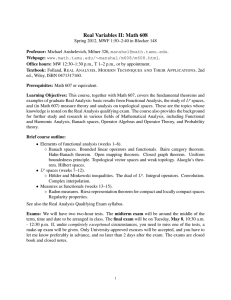Non-Archimedian GP-Spaces N. De Grande-De Kimpe C. Perez-Garcia
advertisement

Non-Archimedian GP-Spaces
N. De Grande-De Kimpe
C. Perez-Garcia∗
Abstract
We study non-archimedean locally convex spaces in which every limited
set is compactoid. In particular, we are interested in spaces of continuous
functions.
1
Preliminaries
Throughout this paper K is a non-archimedean valued field that is complete for
the metric induced by the non-trivial valuation | . |. Also, E,F are Hausdorff locally
convex spaces over K.
A subset B of E is called compactoid if for every zero-neighbourhood U in E
there exists a finite set S ⊂ E such that B ⊂ coS + U , where coS is the absolutely
convex hull of S.
Obviously every compactoid set is bounded, and spaces in which all the bounded
subsets are compactoid have been studied in [5] and [6].
An other interesting subclass of the class of the bounded subsets of E consists of
the limited sets (Definition 2.1). It turns out that every compactoid subset is limited
and therefore it is quite natural to study the spaces E in which every limited set is
compactoid. We call them Gelfand-Philips spaces (GP-spaces) following Lindström
and Schlumprecht who studied such spaces in the complex case (see [10]).
The non-archimedean situation is however completely different from the classical
one (Remark 2.5). In fact, in our case there are ”much more” GP-spaces (Theorem
2.8). In particular - and this is the main objective of this paper- we show that most
of the interesting non-archimedean functions spaces are GP-spaces.
∗
Research partially supported by Comision Mixta Caja Cantabria-Universidad de Cantabria
Received by the editors November 1993
Communicated by R. Delanghe
AMS Mathematics Subject Classification : 46S10
Keywords : p-adic functional analysis, loally convex spaces, GP-spaces.
Bull. Belg. Math. Soc. 1 (1994), 99 - 105
100
N. De Grande-De Kimpe - C.Perez-Garcia
For unexplained terms, notations and background we refer to [15] (locally convex
spaces), [16] (normed spaces) and [4] (tensor products and nuclearity).
2
Limited sets and GP-spaces
Definition 2.1 (Compare [10])
A bounded subset B of E is called limited in E, if every equicontinuous σ(E 0 , E)null sequence in E 0 converges to zero uniformly on B.
Using the natural identification of the σ(E 0 , E)-null sequences in E 0 with the
continuous linear maps from E to c0 ( [2], Lemma 2.2) along with the form of the
compactoid subsets of c0 ( [11], Proposition 2.1), we obtain:
Lemma 2.2 A bounded subset B of E is limited in E if and only if for each continuous linear map T from E to c0 , T(B) is compactoid in c0 .
From this Lemma we easily derive,
Proposition 2.3 .
i) Every compactoid subset of E is limited in E.
ii) If B is limited in E and T ∈ L(E, F ), then T(B) is limited in F (where L(E,F)
denotes the vector space of all continuous linear maps from E to F).
iii) If B is limited in E and D ⊂ B, then D is limited in E.
iv) Let M be a subspace of E and B ⊂ M . If B is limited in M then B is limited
in E . The converse is also true when M is complemented or dense in E (For an
example showing that the converse is not true in general, see Remark 2.9) .
It follows from Lemma 2.2 that if every continuous linear map from E to c0 is
compact, then every bounded subset of E is limited. In particular, if the valuation
on K is dense, we have
Corollary 2.4 If the valuation on K is dense then the unit ball of l∞ is limited
(non-compactoid) in l∞ .
Remark 2.5 Corollary 2.4 shows that, for densely valued fields, the behaviour of
limited sets in non-archimedean analysis is in sharp contrast with the one in locally
convex spaces over the real or complex field. For this difference compare e.g. [1],
Proposition, property 6, [8], Theorem 1 and [9], Proposition 1) with our results.
We’ll see in Theorem 2.8.iii) that this difference is even more striking when the
valuation on K is discrete.
Definition 2.6 Compare [10])
A locally convex space E is called a Gelfand-Philips space (GP-space in short) if
every limited set in E is compactoid.
The following is easily seen:
Non-Archimedian GP-Spaces
101
Proposition 2.7 .
i) A subspace of a GP-space is a GP-space.
ii) The product of a family of GP-spaces is a GP-space.
Theorem 2.8 .
i) Every locally convex space E of countable type is a GP-space.
ii) Every Banach space E with a base is a GP-space.
iii) If the valuation on K is discrete then every locally convex space over K is a
GP-space.
PROOF
i) From Lemma 2.2 it follows that c0 (and hence every normed space of countable
type) is a GP-space. Then use the fact that E can be considered as a subspace of
Q
p∈P Ep , where P is a family of seminorms determining the topology of E and for
each p ∈ P, Ep is the normed space E/kerp. Now all the Ep are of countable type.
Then apply Proposition 2.7
ii) Let A ⊂ E be limited. We can assume that A is absolutely convex. It suffices
to prove that every countable subset B of A is compactoid. Let [B] stand for the
closed linear hull of B. Then ([16] Corollary 3.18) [B] is complemented in E and so,
by Proposition 2.3.iv) we have that B is limited in [B]. By i) B is compactoid in
[B] and hence in E.
Q
iii) Again use the fact that E ⊂ p∈P Ep where now each of the spaces Ep has a
base ([16], Theorem 5.16). Then apply ii) and Proposition 2.7
Remark 2.9 Property iv) of Proposition 2.3 is not true in general. For example,
let the valuation on K be dense, take E = l∞ , M = c0 and B the unit ball in c0 .
Then, apply 2.4, 2.3.i) and 2.8.i).
3
Spaces of continuous functions
Let X be a Hausdorff zero-dimensional topological space. We consider the following K-valued function spaces:
PC(X): The space of all continuous functions f : X −→ K for which f(X) is
precompact, endowed with the toplogy τu of uniform convergence.
C(X): The space of all continuous functions X −→ K endowed with the compact
open topology τc .
BC(X): The space of all bounded continuous functions X −→ K, endowed with
the uniform topology τu or with the strict topology τβ . This last one is the topology
generated by the seminorms pφ (f ) = supx∈X | φ(x).(f (x) |, where φ : X −→ K is a
bounded function vanishing at infinity.
Since P C(X) is a Banach space with a base ( [16] Theorem 3.4) we obtain
inmediately from 2.8.ii),
Theorem 3.1 PC(X) is a GP-space.
We now tackle the GP-property for C(X) and BC(X).
102
N. De Grande-De Kimpe - C.Perez-Garcia
Lemma 3.2 Let K be a compact subset of X. Then, for every clopen set G in K
there exists a clopen set UG in X such that G = UG ∩ K.
PROOF
Let τX be the original topology on X and τK the trace of τX on K.
Let G ⊂ K be τK -clopen. Clearly, there exists U ⊂ X, τX -open, such that
G = K ∩ U . Also, for each a ∈ G ⊂ U , there exists a τX -clopen set Wa in X with
a ∈ Wa ⊂ U . Then use a compactness argument.
Theorem 3.3 (Compare [12], Theorem 3.3) For a set F ⊂ C(X), the following
properties are equivalent:
i) F is compactoid in C(X).
ii) For every compact set K ⊂ X the set F | K is compactoid in C(K) (where
F | K is the set of the restrictions f | K of f to K with f ∈ F).
PROOF
i) ⇒ ii): This follows directly from the fact that, for each compact set K ⊂ X,
the restriction map
C(X) −→ C(K) : f −→ f | K
is linear and continuous.
ii) ⇒ i): Let U be a zero-neighbourhood in C(X). We can assume that U has
the form
U = {f ∈ C(X) : supx∈X | f (x) |≤ ²}, ² > 0, K compact subset of X.
We have to find f1 , . . . , fr ∈ C(X) such that
F ⊂ co{f1 , . . . , fr } + U.
(1)
Put UK = {g ∈ C(K) : supx∈K | g(x) |≤ ²}. Then, since F | K is compactoid in
C(K), there exist g1 , . . . , gr ∈ C(K) such that
F | K ⊂ co(g1 , . . . , gr ) + UK .
(2)
Fix m ∈ {1, . . . , r} and put V = {e ∈ K :| e |≤ ²}. Since gm (K) is compact
in K, there are e1m , . . . , esm ∈ K such that the sets e1m + V, . . . , esm + V are
disjoint and
gm (K) ⊂ (e1m + V ) ∪ . . . ∪ (esm + V ).
1
s
i
Then {Km
, . . . , Km
}, where Km
= {x ∈ K : gm (x) ∈ eim + V } (i = 1, . . . , s),
constitutes a partition of K consisting of τK -clopen subsets of K. Hence, for each
0
0
m ∈ {1, . . . , r} the locally constant function gm
: K −→ K defined by gm
(x) = eim
i
0
for x ∈ Km is continuous and it has the property supx∈K | gm (x) − gm (x) |≤ ². So
( 2) can be changed into
F | K ⊂ co(g10 , . . . , gr0 ) + UK .
0
has a locally constant continuous exBy lemma 3.2, each of the functions gm
tension fm : X −→ K (m = 1, . . . , r). Then, f1 , . . . , fr satisfy ( 1) and we are
done.
Non-Archimedian GP-Spaces
103
Corollary 3.4 C(X) is a GP-space.
PROOF
Let F ⊂ C(X) be a limited set. Then (Proposition 2.3.ii)) for each compact set
K ⊂ X, F | K is limited in C(K) and hence compactoid in C(K) (Theorem 3.1).
Now apply Theorem 3.3.
Corollary 3.5 BC(X), τβ is a GP-space .
PROOF
Let F ⊂ BC(X) be a τβ -limited set. Since τβ is finer than τc ( [7], Proposition
2.10) we obtain from Proposition 2.3.ii) that F is τc -limited in BC(X). By Propsition 2.7.i) and Corollary 3.4 we have that F is compactoid in BC(X), τc . Now
apply Corollary 2.9.a) and Proposition 2.11 of [7].
The picture changes completely when we endow BC(X) with the uniform topology τu . We have:
Theorem 3.6 If the valuation on K is dense (Compare 2.8.iii)), then BC(X), τu
is a GP-space if and only if X is pseudocompact.
PROOF
If X is pseudocompact one verifies that BC(X) = P C(X). Then apply Theorem
3.1.
If X is not pseudocompact, then BC(X), τu contains a subspace which is linearly
homeomorphic to l∞ (see [14], proof of Corollary 2.7). Then apply Proposition 2.7.i)
and Corollary 2.4.
In [4] (resp. [3]) the nuclearity of the locally convex space C(X), τc (resp.
BC(X), τβ ) is characterized. Combining those results with Corollaries 3.4 and
3.5 we obtain:
Theorem 3.7 The following are equivalent:
i) C(X), τc is nuclear.
ii) BC(X), τβ is nuclear.
iii) Every τc -bounded subset of C(X) is limited.
iv) Every τβ -bounded subset of BC(X) is limited.
We now consider tha case where the continuous functions have their values in
a polar complete locally convex Hausdorff space E. We define the function spaces
P C(X, E), τu ; C(X, E), τc ; BC(X; E), τu and BC(X, E), τβ in the canonical way
and we then have:
Theorem 3.8 .
i) PC(X,E) is a GP-space if and only if E is a GP-space.
ii) C(X,E) is a GP-space if and only if E is a GP-space.
iii) BC(X,E),τβ is a GP-space if and only if E is a GP-space.
iv) If the valuation on K is dense, then BC(X, E), τu is a GP-space if and only
if X is pseudocompact and E is a GP-space.
104
N. De Grande-De Kimpe - C.Perez-Garcia
PROOF
The proof of ii), iii), iv) is essentially the same as in the K-valued case.
For the proof of i) one needs [13] Theorem 1.3 and the following result.
Theorem 3.9 Let E and F be complete, polar, locally convex Hausdorff spaces.
ˆ , the completion of the tensor product for its canonical topology, is a
Then E ⊗F
GP-space if and only if E and F are GP-spaces.
PROOF
The consecutive steps are:
i) If E is quasicomplete, then (Ec0 )0 = E, where Ec0 is the dual E 0 of E endowed
with the topology τcp of uniform convergence on the compactoid subsets of E.
ii) If E is quasicomplete. Let H ⊂ L(Ec0 , F ) be such that H(U o ) is compactoid
in F for all zero-neighbourhoods U in E and H ∗ (V o ) is compactoid in E for all
zero-neighbourhoods V in F . Then, H is compactoid in L² (Ec0 , F ), where the ²
means that we consider on L(Ec0 , F ) the topology of uniform convergence on the
equicontinuous subsets of E 0 .
iii) If E and F are GP-spaces, E quasicomplete, then L² (Ec0 , F ) is also a GP-space.
(As a consequence, E ⊗ F is a GP-space if and only if E and F are GP-spaces).
iv) If E and F are complete, then so is L² (Ec0 , F ). The Theorem is then a direct
consequence of this result.
The proofs of ii) and iii) are similar to the archimedean case (see [10]) and are
therefore omitted. The proof of iv) is standard. So let us prove i):
Since E is quasicomplete and by [15], Theorem 5.12, it follows that τcp is the
topology of uniform convergence on the sets A ⊂ E which are absolutely convex,
compactoid, edged and σ(E, E 0 )-complete. Since the family of these sets form a
special covering of E (see [15], Definition 7.3), the conclusion follows from [15],
Proposition 7.4.
Note that i) is not true in general.
Indeed, take E = coo and let x1 , x2 . . . be a non-convergent Cauchy sequence in
E. Then, the map T : E 0 −→K : f −→ limn f (xn ) is an element of (Ec0 )0 . But T
cannot be represented by an element of E.
References
[1] J. Bourgain and J. Diestel, Limited Operators and Strict Cosingularity, Math.
Nachr. 119 (1984), 55-58.
[2] N. De Grande-De Kimpe, Structure theorems for locally K-convex spaces, Proc.
Kon. Ned. Akad. v. Wet. A80 (1977), 11-22.
[3] N. De Grande-De Kimpe and S. Navarro, The non-archimedean space BC(X)
with the strict topology, (preprint).
[4] ——, Non-archimedean nuclearity and spaces of continuous functions, Indag.
Math. N. S., 2 (1991), 201-206.
Non-Archimedian GP-Spaces
105
[5] N. De Grande-De Kimpe and C. Perez-Garcia, P-adic semi-Montel spaces and
polar inductive limits, Results in Mathematics, 24 (1993), 66-75.
[6] N. De Grande-De Kimpe, C. Perez-Garcia and W.H. Schikhof, Nonarchimedean t-frames and FM-spaces, Canad. Math. Bull. 35(2) (1992), 1-9.
[7] A.K. Katsaras, The strict topology in non-archimedean vector valued function
spaces, Proc. Kon. Ned. Akad. v. Wet. A87 (1984), 189-201.
[8] M. Lindström, A characterization of Schwartz spaces, Math. Z. 198 (1988),
423-430.
[9] —–, A note on Fréchet-Montel spaces, Proc. Amer. Math. Soc. 108 (1990), no
1, 191-196.
[10] M. Lindström and T. Schlumprecht, On limitedness in locally convex spaces,
Arch. Math. 53 (1989), 65-74.
[11] C. Perez-Garcia, On compactoidity in non-archimedean locally convex spaces
with a Schauder basis, Proc. Kon. Ned. Akad. v. Wet. A91 (1988), 85-88.
[12] C. Perez-Garcia, P-adic Ascoli theorems and compactoid polynomials, Indag.
Math. NS., 3(2) (1992), 203-210.
[13] C. Perez-Garcia and W.K. Schikhof, Tensor product and p-adic vector valued
continuous functions, To appear in the Proceedings of the 2nd International
Conference on p-adic analysis (Santiago, Chile 1992)
[14] —–, The Orticz-Pettis property in p-adic analysis, To appear in Collectanea
Mathematica (1993).
[15] W.H. Schikhof, Locally convex spaces over non-spherically complete valued
fields I-II, Bull. Soc. Math. Belgique (ser. B) XXXVIII (1986), 187-224.
[16] A.C.M. van Rooij, Non-archimedean Functional Analysis, Marcel Dekker, New
York, 1978.
N. De Grande-De Kimpe
Department of Mathematics
Vrije Universiteit Brussel
Pleinlaan 2 (10F7)
B-1050 Brussel
BELGIUM
C. Perez-Garcia
Departamento de Matematicas
Universidad de Cantabria
Av. de los Castros s/n
39071 Santander
SPAIN





